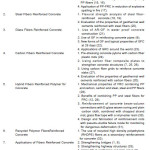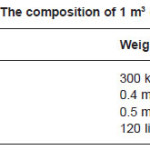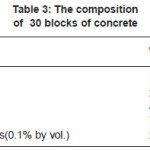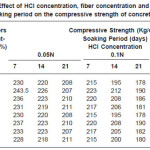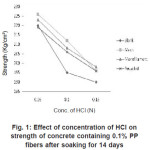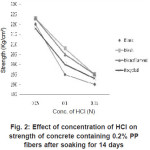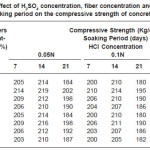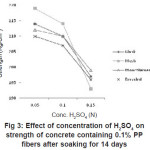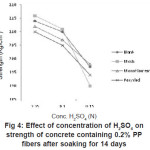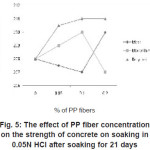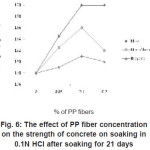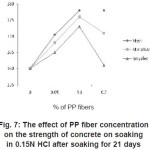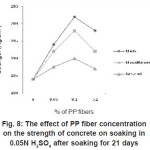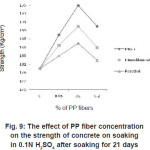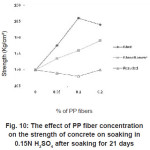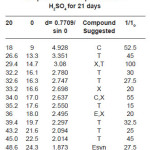Introduction
Fiber-reinforced composites, today, are used in variety of applications ranging from replacements for steel reinforcement in concrete, jackets for retrofit of columns, and externally bonded reinforcement for the rehabilitation of deteriorating structural systems, to use in all composite structures such as building frames and even bridge decks.1
The fibers used are mainly steel fibers, carbon fibers and polymer fibers. Among the polymer fibers, polypropylene (PP) fibers have attracted most attention due to the outstanding toughness of concrete reinforced with them.2 Using the concept of hybridization3,4 with two different fibers incorporated in a common cement matrix, can offer the hybrid composite more attractive engineering properties.
For the purpose of improving the workability, drying shrinkage, durability, impact resistance and impermeability of concrete, fiber reinforced polymer (FRP) concretes are produced using steel, glass, polymer or carbon fibers.5
As it is k nown that concrete is a relatively brittle material, reinforcement with randomly distributed short fibers may improve the toughness of cementitious matrices by preventing or controlling the initiation, propagation or coalescence of cracks (6). However, concrete is a complex material with multiphase. The phases include large amount of calcium silicate hydrate (C-S-H) gel in micron scale size, sands in millimeter scale size, and coarse aggregates in centimeter scale size. Thus, the properties of concrete will be improved in a certain level, but not whole levels if reinforced only by one type of fiber.
Many researchers (7, 8 and 9) have discussed the various applications of Fiber-Reinforced Concrete (FRC), especially in the retrofitting and rehabilitation of deteriorated concrete structures. The benefits of incorporating fibers to concrete may be summed up as inhibiting the formation of plastic shrinkage cracking, reducing plastic settlement cracking, improving cohesion, reducing water permeability, increasing green strength (first 24 hours), providing restrained shrinkage cracking control and providing higher impact resistance and higher toughness.10,11
Table 1 lists the recent research and development activities in fiber reinforcement of concrete over the past several years as cited in literature. Some commentaries and/or a brief summary on some of these research activities are made hereunder.
Table 1: Recent research and development activities in fiber reinforcement of concrete
Topics 1, 2, 3 and 4 in Table 1 are mainly concerned with the influence of the incorporation of the most commonly used fibers – polypropylene, steel, glass and carbon–on the properties of concrete. While as, Topic 5 in the same table deals with research works concerned with hybrid fiber reinforced concrete. Researchers in the Composites Manufacturing Technology Center (CMTC) at Penn State University have investigated the use of smart hybrid fiber reinforced plastic composites as an improved reinforcement for concrete structures (31).
Auchey³² suggested the use of recycled high density polyethylene (RHDPE) fiber as a secondary reinforcement in Portland cement concrete structures–Topic 6. Topic 7 considers the applications of FRC, while as topic 8 in the same table–Theoretical and Experimental analysis of FRPC–may be beneficial in designing and setting a model for load calculations of FRPC systems. However, this topic is of little interest to the author as far as concerned in this article.
The main target of the present research is to study the possibility of utilizing used (recycled) PP packages in the reinforcement of concrete as an alternate for the virgin mono-filament and mesh PP currently in use in FRC. The over-arching benefits of loading concrete with used PP may be summarized as:
Reducing the cost of FRC as a step towards wider range of applications
Utilizing a solid waste as a step towards a cleaner environment.
Methodology
In the present work, efforts are directed towards studying the effect of incorporating PP fibers to concrete on its compressive strength. For achieving this objective, the current study procedures focus on the following:
PP fibers of different geometry (mesh, monofilament and recycled) are added to concrete blocks, in an attempt to study the effect of each type on the reinforcement of concrete.
Different concentrations of PP fibers, namely: 0.1% by volume, equivalent to 900 gm fiber/m3 concrete and 0.2% by volume, equivalent to 1800 gm fiber/m3 concrete are incorporated to concrete, so as to select the concentration imparting most considerable enhancement in the strength to FRC.
The concrete specimens are subjected to both normal (soaking in water) and severe (soaking in acids at various concentrations) conditions for periods of time: 7, 14 and 21 days, so as to assume conditions similar to those naturally encountered by concrete blocks.
Compressive strength test was applied for all prepared blocks after soaking for 7, 14 and 21 days and the average values are recorded. The results obtained for the reinforced concrete are compared with those of the blank sample. Worthy to mention, that the compressive strength of the concrete blocks loaded with PP fibers is taken, in the current research work, as a preliminary criterion for determining the performance of PP fibers as a reinforcement material in FRC.
Experimental
The following section describes, in full details, the experimental work that has been done to realize the above mentioned methodology.
Materials
Cement
Ordinary Portland Cement with the following composition: Tricalcium Silicate (C3S), Dicalcium Silicate (C2S), Tricalcium Aluminate (C3A), Tetra Calcium Aluminoferrite (C4AF), Minor Oxides as (MgO, TiO2, K2O, Na2O…) is provided by the Egyptian Cement Company.
Sand and Gravel
The sand is of mesh no.: maximum 4.76, minimum 1.77, while as the average diameter of the gravel is 13 mm.
Fibers
Three different types of polypropylene fibers, namely: Mono Filament, Mesh and Recycled (used) are incorporated into the concrete mix for inhibiting cracking in the plastic phase of concrete. The specifications of each type are as follows:
Mono Filament
100% virgin PP fibers with18 microns diameter, 12 mm length and a specific surface area< 22 m2/kg.
Mesh
100% virgin PP fibers with Welded-wire shape
Recycled (used)
Food and rice packages are used as a source of recycled PP fibers, cut into average length of 2 cm and used without any treatment.
Acids
Sulfuric and Hydrochloric Acids, provided by El Nasr Laboratory Chemicals are used with concentrations (0.05, 0.1 and 0.15 N)
Techniques
Table (2) shows the composition of 1 m3 concrete while table (3) shows the amounts of raw materials consumed to prepare 30 concrete blocks of dimensions 10x10x10 cm.
Cement, sand and gravel are placed in a mechanical mixer then the calculated amount of water is added to form a homogenous mixture. During mixing the required amount (0.1 and 0.2%) of PP fibers, of different geometry (mono-filament, mesh and recycled), is added to achieve a uniform mixture. Mixing is continued until a homogenous mixture of reinforced concrete is obtained. A certain amount of this mixture is placed in the mould in order to be completely filled. The moulds are placed on a shaker for 2 minutes in order to get compact concrete blocks. Those are left for 24 hours to be dried. The blocks are soaked in water for 7 days, and then left in air to be dried. The blocks are weighed and soaked in H2SO4 and HCl acids of different concentrations (0.05, 0.10 and 0.15N) for various periods of time (7, 14, 21 days). After the specified duration of soaking in the acid, the blocks are picked out, left to dry and finally weighed prior being subjected to the compressive strength test.
Table 2: The composition of 1 m3 concrete
Table 3: The composition of 30 blocks of concrete
Testing
Compressive Strength Test
The compressive strength for the mentioned samples was measured using a tensile strength machine: “TINIUS TOLSEN”, Willow Grove, PA., U.S.A, Model 290 Display. The test was applied for the prepared blocks after 7, 14 and 21 days and the average values were recorded. The same procedures were carried out for: blank samples as well as samples loaded with different fiber concentrations to investigate the effect of incorporating PP fibers with different concentrations on the compressive strength of concrete.
X-Ray Analysis
X-Ray analysis was applied by using “Compact XRD Analyzer”.
Results
Effect of Acid Concentration, Fiber Concentration and Geometry, and Soaking Period
Soaking in HCl
Table 4 exhibits the effect of incorporating PP fibers with different geometry on the strength of concrete after soaking in three different concentrations of HCl (0.05, 0.1 and 0.15N). The graphical representation of the results is illustrated in Figs 1 and 2. From the mentioned table and figures, it is obvious that the performance of concrete is enhanced by the addition of different geometry of fibers in comparison to plain concrete. The best performance was encountered with the concrete blocks reinforced with PP fibers (mesh): these gave the highest strength after soaking in different concentration of HCl for various time periods. On the other hand, the least reinforcement was noticed for the concrete reinforced with recycled PP fibers.
It may also be noticed that increasing the acid concentration from 0.05 to 0.15N causes significant deterioration in the compressive strength of the samples under test, especially in the plain concrete sample where the compressive strength dropped from 208 to 160 Kg/cm2 after soaking for 21 days. Meanwhile, there is no significant change noticed in the measured compressive strength due to the change in the acid concentration from 0.05 to 0.1N.
Table 4: Effect of HCl concentration, fiber concentration and geometry and soaking period on the compressive strength of concrete blocks
Figure 1: Effect of concentration of HCl on strength of concrete containing 0.1% PP fibers after soaking for 14 days
Figure 2: Effect of concentration of HCl on strength of concrete containing 0.2% PP fibers after soaking for 14 days
Soaking in H2SO4
Table 5 exhibits the effect of incorporating PP fibers with different geometry on the strength of concrete after soaking in H2SO4 with the same three concentrations applied while soaking in HCl. Figs 3 and 4 represent the obtained results. Similar to the effect witnessed in the case of soaking in HCl, the incorporated PP fibers led to an increase in the compressive strength of the samples possessing fibers with different geometry over that of the blank sample. The best performance was encountered with the concrete blocks reinforced with mesh PP fibers; these gave the highest strength after soaking in different concentrations of H2SO4 for various time periods. On the other hand, the least reinforcement was noticed for the concrete reinforced with recycled PP fibers. It was also noticed that on increasing H2SO4 concentration, the strength significantly decreased.
The highest strength for the three types of PP fibers was recorded after 14 days, after which the strength deteriorated rapidly until it reached the lowest value after 21 days. On soaking in (0.05N) H2SO4 for 7 days, the concrete blocks containing 0.1% PP fibers (mesh) gave strength of 214 kg/ cm2. Then this value increased, unexpectedly; on the 14th day it gave 219 kg/cm2, yet it decreased on further soaking in the acid. On the 21st days it gave a value of 202 kg/cm2.
Table 5: Effect of H2SO4 concentration, fiber concentration and geometry and soaking period on the compressive strength of concrete blocks
Figure 3: Effect of concentration of H2SO4 on strength of concrete containing 0.1% PP fibers after soaking for 14 days
Figure 4: Effect of concentration of H2SO4 on strength of concrete containing 0.2% PP fibers after soaking for 14 days
Effect of Fiber Concentration
Figs 5 – 10 demonstrate the effect of increasing the percentage of PP fibers added to concrete on the compressive strength of FRC when subjected to specific acid concentration for 21 days. It is clear from these figures that on increasing the fibers percentage in concrete from 0.05% (by volume) to 0.1%, the strength of the concrete blocks was found to be of higher values. Yet, further increase in the fibers content led to decrease in strength. Increasing the percentage of the PP fibers added to concrete has a reversed effect on strength of concrete as when the percentage of PP fibers increased, the strength decreased. FRC containing monofilament and recycled PP fibers of 0.2% gave the same strength similar to FRC containing monofilament and recycled PP fibers of 0.1% only after 14 days. After 7 and 21 days the strength of concrete containing monofilament and recycled PP fibers decreased as the percentage of PP fibers increased.
Figure 5: The effect of PP fiber concentration on the strength of concrete on soaking in 0.05N HCl after soaking for 21 days
Figure 6: The effect of PP fiber concentration on the strength of concrete on soaking in 0.1N HCl after soaking for 21 days
Figure 7: The effect of PP fiber concentration on the strength of concrete on soaking in 0.15N HCl after soaking for 21 days
Figure 8: The effect of PP fiber concentration on the strength of concrete on soaking in 0.05N H2SO4 after soaking for 21 days
Figure 9: The effect of PP fiber concentration on the strength of concrete on soaking in 0.1N H2SO4 after soaking for 21 days
Figure 10: The effect of PP fiber concentration on the strength of concrete on soaking in 0.15N H2SO4 after soaking for 21 days
X-Ray Analysis
On observing the results presented in tables 4 and 5, it is easily noticed that the concrete blocks soaked in H2SO4 for 14 days exhibited a behavior trend which is totally un-similar to that encountered for the concrete blocks soaked in HCl. The trend of these blocks, whatever the type of fiber incorporated, gave an increase in weight and compressive strength. Then after 21 days, these blocks gave the normally expected trend; the weight and compressive strength of concrete blocks decreased.
To explain this contradiction in the results, and well-understand the effect of sulfuric acid on the compressive strength of the concrete, X-Ray analysis was applied to only one of these blocks soaked in H2SO4 and for the blank sample as well. Table 6 shows the results of the X-Ray analysis for both the blank sample and the sample soaked in H2SO4 for 21 days.
Table 6: X-Ray analysis for both the blank sample and the sample soaked in H2SO4 for 21 days
Interpretation of Results
From the above results, it is apparent that incorporating PP to concrete blocks led to an enhancement in the compressive strength with increasing the incorporated-fiber concentration up till 0.1%. This may be attributed to the presence of tobermorite and portlandite which are responsible for the strength of the concrete matrix. A high peak at incidence angle of (Ø= 21o) was depicted, on X-Ray analysis which signifies the presence of the calcium silicate hydrate phase known as (Tobermorite). Also, another compound calcium hydroxide known as (Portlandite) was present in high amounts.
The deterioration in the compressive strength on increasing the fiber concentration above 0.1%, above which the compressive strength decreased. This may be ascribed to the fact that on increasing the percentage of PP fibers into concrete, the porosity decreases since excess fibers block the pores and thus reduce the porous area and consequently the strength decreases significantly.
It was observed that on soaking in H2SO4, the highest strength for the three types of PP fibers was recorded after 14 days, after which the strength deteriorated rapidly. This result may be interpreted as follows: The increase in weight and strength which happened to the samples after soaking for 14 days is due to a reaction between the small amounts of calcium hydroxide produced during hydration with H2SO4 which absorbed the excessive water; consequently, gave false setting so the strength of concrete increased.
The decrease in the compressive strength detected in all samples after soaking in both acids at various concentrations for 21 days is clearly elucidated by the XRD of the soaked samples in sulfuric acid solutions (0.15N) after 21 days which showed that the content of calcium hydroxide remains at its previous level. However, a drop in the amount of Tobermorite in the samples is observed thus explaining the decrease in the compressive strength values.
Worth mentioning that the strength of concrete blocks after soaking in HCl can be arranged in the following order: Mesh < monofilament < recycled < blank. Meanwhile, the strength of concrete blocks after soaking in H2SO4 can be arranged in the following orders: Mesh < monofilament < blank < recycled.
Conclusions
Incorporating PP to concrete blocks led to an enhancement in the compressive strength with increasing the incorporated-fiber concentration.
Increasing the fiber concentration above 0.1% leads to deterioration in the compressive strength.
Soaking period and acid type has a significant effect on the compressive strength of the FRC.
Utilizing used (recycled) PP packages in the reinforcement of concrete as an alternate for the virgin mono-filament and mesh PP currently in use in FRC may be applied with a vision of reducing the cost of FRC and utilizing a solid waste as a step towards a cleaner environment.
References
- www. Elsevier.com/ locate/ compstruct, cited in August (2004).
- Bayasi, Z. and Zeng, J., Properties of polypropylene fiber reinforced concrete, ACI Mater. J., 90(6): 605-610 (1993).
- Kakemi, M. and Hannant, D.J., Mathematical model for tensile behaviour of hybrid continuous fiber cement composites, Composites, 26(9): 637-643 (1995).
CrossRef
- Mobasher, B. and Li, C.Y., Mechanical properties of hybrid cement- based composites, ACI Mater. J., 93(3): 284-292 (1996).
- Ohama,Y., Polymer-based admixtures, Cement and Concrete Composites, 20: 189-212 (1998).
CrossRef
- Soroushian, P., Khan, A. and Hsu, J.W., Mechanical properties of concrete materials reinforced with polypropylene or polyethylene fibers, ACI Mater. J., 89(2): 535-540 (1992).
- Clarke, J., Design guidance for strengthening concrete structures using fiber composite materials, Concrete, 35(1): 16-18 (2001).
- Sakda, B., Strengthening bridges with fiber reinforced polymers, Concrete, 34(2): 42, 43 (2000).
- Farahar, B., Glass fiber reinforced concrete pipes, Concrete, 34(10): 78, 79 (2000).
- www.fibermesh.com/engineers/main.asp, cited in August (2004).
- www. fiber mesh . com/transpor tation/ main.asp, cited in August (2004).
- Beningfield, N. and Chapman, C., New ways for concrete slabs, Concrete, 35(9): 56, 57 (2001)
- Carr, K., Designing with high-performance polymer fibers, Concrete, 35(9): 48-50 (2001).
- Kitchen, A., Fibers in floor screeds, Concrete, 35(9): 54, 55 (2001).
- Wang, K., Shah, S.P. and Phuaksuk, P.,Plastic shrinkage cracking in concrete materials, ACI Mater. J., 98(6): 458-464 (2001).
- Junior, S.F. and Hanai, J.B., Prestressed fiber reinforced concrete beams with reduced ratios of shear reinforcement, Cement and Concrete Composites, . 21: 213-221 (1999).
CrossRef
- Kitchen, A., Polypropylene fibers reduce explosive spalling in fire, Concrete, 35(4), 40-41 (2001).
- Bindiganavile, V. and Banthina, N., Polymer and steel fiber-reinforced cementitious composites under impact loading-Part 2, ACI Mater. J., 98(1): 17-24 (2001).
- Singh, S.P. and Kaushik, S.K, Flexural fatigue analysis of steel fiber-reinforced concrete, ACI Mater. J. 98(4): 306-312 (2001).
- Berndt, M.L. and Philippacopoulos, A.J., Incorporation of fibers in geothermal well cements, Geothermics, 31: 643-656 (2002).
CrossRef
- Friedrich, T., Glass fibers in water proof concrete construction, Concrete, 35(1): 65-67 (2001).
- Muller, D. and Morrison, I., Recent developments in glass fiber reinforced concrete, Concrete, . 34(5): 47-49 (2000).
- Ferry, R., Where is glass fiber reinforced concrete going? Concrete, 34(9): 62, 63 (2000).
- Terrasi, G., Battig, G., and Bronnimann, R.,Spun concrete pylons prestressed with ncarbon fiber reinforced plastic, Concrete, 35(6): 18, 19 (2001).
- Lorenzis, L., Miller, B., and Nanni, A., Bond of fiber reinforced polymer laminates to concrete, ACI Mater. J., 98(3): 256-264 (2001).
- Volnyy, V.A. and Pantelides, C.P., Bond length of CFRP composites attached to precast concrete walls, J. of Comp. for Const., ASCE, 3(4): 168-176 (1999).
- Zhang, B., Masmoudi, R. and Benmokrane, B., Behaviour of one-way concrete slabs reinforced with CFRP grid reinforcements, Const. and Build. Mater. 18: 625-635 (2004).
CrossRef
- Yao, W., Li, J. and Wu, K., Mechanical properties of hybrid fiber-reinforced concrete at low fiber volume fraction, Cement and Concrete Res., 33: 27-30 (2003).
CrossRef
- Carr, K., Polypropylene and steel fiber combinations, Concrete, 34(9): 60-61 (2000).
- Li, J.; Bakoss, S.L.; Samali, B. and Ye, L., Reinforcement of concrete beam-column connections with hybrid FRP sheet, Composite Structures. 47: 805-812 (1999).
CrossRef
- w w w. e s m . p s u e d u / d e p t i n fo / C M T C / smartrod.html, cited in August (2004).
- Auchey, F.L., Feasibility study: Using recycled polymer fiber as a secondary reinforcement in concrete structures, ASC proceedings of the 34th Annual Conference, Central Connecticut State University- New Britain (1998).
- Loudon, N., Strengthening high way structures with fiber reinforced composites, Concrete, 35(6): 16 (2001).
- Rasheed, H.A.; Nayal, R. and Melhem, H., Response prediction of concrete beams reinforced with FRP bars, Composite Structures, 65: 193-204 (2004).
CrossRef
- Aeillo, M.A., Focacci, F. and Nanni, A., Effects of thermal loads on concrete cover of fiber reinforced polymer reinforced elements, ACI Mater. J., 98(4): 332-339 (2001).

This work is licensed under a Creative Commons Attribution 4.0 International License.
 Material Science Research India An International Peer Reviewed Research Journal
Material Science Research India An International Peer Reviewed Research Journal

